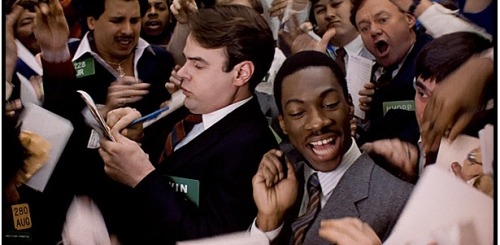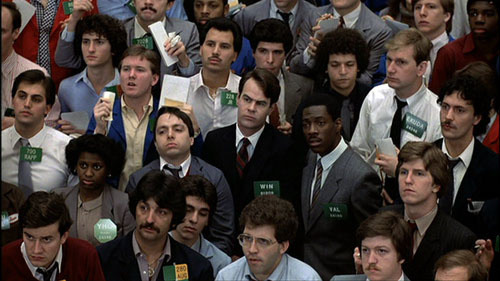“Mortimer: That’s not right. How can the price be going down?
Randolph: Something’s wrong! … They’re selling, Mortimer! … You, idiot! Get back in there at once and sell! Sell!”
Billy Ray, we are not looking good this morning.
S&P 500 futures were some 35 handles lower at last check following a North Korean nuclear test and a dismal Chinese non-manufacturing PMI report. We appear likely to test Monday’s lows on the opening.

“What we have learned from history is that we haven’t learned from history.” –Benjamin Disraeli
Let me underscore this morning that rationality wilts and gets sedated in the market when large doses of effortless money are administered (i.e. Federal Reserve stimulus).
At best, a calm occurs. At worse, an unrealistic “bull market in complacency” forms. Investors come to believe that central bankers will indefinitely prevent our markets from returning to normal “price discovery.” A new paradigm emerges in which players convince themselves that history doesn’t matter.
But reality sets in at some point, leaving investors with the “bag-holder blues” (to quote late financial writer Joe Granville). Or, to quote late mega-investor John Templeton, “The four most expensive words in the English language are: ‘This time it’s different.’”
Market watcher John Hussman has eloquently pointed out that those who still embrace the bubble in global stock prices will eventually sit down to a banquet of consequences.
“At the peak of every speculative bubble, there are always those who have persistently embraced the story that gave the bubble its impetus in the first place,” he wrote. “As a result, the recent past always belongs to them, if only temporarily. Still, the future inevitably belongs to somebody else. By the completion of the market cycle, no less than half (and often all) of the preceding speculative advance is typically wiped out.”
Citing Carmen Reinhart and Kenneth Rogoff’s classic book This Time Is Different, Hussman added: “Every boom and bust have the same qualities. The hubris and arrogance of financial ‘experts’ and government apparatchiks makes them think they are smarter than those before them.
“They always declare this time to be different due to some new technology or reason why valuations don’t matter,” Hussman wrote. “The issuance of speculative debt and seeking of yield due to Federal Reserve suppression of interest rates always fuels the boom and acts as the fuse for the inevitable explosive bust.”
Are We Safe as Markets Presume?
I’ve written repeatedly over the last year that the one question I ask myself every morning is: “Are we as citizens and investors as safe in a flat, connected and networked world as markets presume we are?”
That question, coupled with a slew of fundamental concerns (geopolitical, social, political, economic and profit-related), forms the basis of my cautious market view.
I’ve expressed my view that both the fundamental and technical deterioration – i.e., the narrowing market leadership that began in late 2014 – were sowing the seeds for an important, broad-market top.
In my columns Short in May and Go Away and A Touch of Red May Be Ahead, I long ago identified last spring as the start of a cyclical S&P 500 top. And last month, I even expressed my negativity with some hyperbole (and a measure of frustration that the market had not yet conformed to my design) through two Dr. Seuss parodies, Green Eggs and Stocks: Neither Rocks and The Bull in the Hat.
I juxtaposed the above with my expectation that an “Ah Ha Moment” was at hand – a point in time when investors would lose confidence in the Fed and its policies. I also summarized all of this in my 15 Surprises for 2016 (parts one and two), which took a very negative tone and warned of a difficult year ahead.
A Broken Market Mechanism
The market mechanism has become broken, with machines and algos taking a more-dominant role – filling the vacuum left by the exit of individual investors and a less-active hedge-fund community.
Distortions and malinvestments are occurring as a result, meaning strategies that worked in the past begin to fail – as do the money managers who relied on them.
More “liquid-alternative” mutual funds closed last year than in any previous other year on record, including those run by JPMorgan Chase (JPM) and Guggenheim Partners. We’ve also recently seen several hedge-fund firms (including Whitebox, Lutetium, SAB Capital and Seneca) announce plans to close some or all of their funds.
If these “Masters of the Universe” – the supposed best and brightest minds on Wall Street – can’t figure out our markets, what chance do we mere mortals have?
If my market fears come true this year, it’s inevitable that Main Street and the real economy will suffer the adverse impacts of a broken market mechanism and falling stock prices. The word “contagion” hasn’t been heard a lot since 2008, but it might appear again in 2016. Actually, we might have already been feeling the market’s contagious effects over the past two weeks.
“Surprise No. 3: ‘The Mother of All Flash Crashes’
One of these cyber-attacks causes ‘The Mother of All Flash Crashes,’ which scares the hell out of many market participants. The Dow Jones Industrial Average falls by 1,100 points – the largest one-day point decline in history.”
– Doug’s Daily Diary, 15 Surprises for 2016 (Part One) (Dec. 29, 2015)
What I’m most fearful of is the possibility (as expressed above) that once the market moves down decisively, risk-parity and gamma-hedging strategies will exacerbate the market downturn – just as portfolio insurance did during the 1987 Wall Street crash.
Most players shouldn’t short stocks. But that said, I currently have 18 stocks and indices on my “Best Short Ideas” list. I don’t know many commentators who have such a broad menu of shorts that they recommend.
The Bottom Line
“It ain’t cool being no jive turkey so close to Thanksgiving.” – Trading Places

This is no drill. I’ve consistently argued that investors should err on the side of conservatism these days, and that T.I.N.A. (“There Is No Alterative” to stocks) is B.S. (With apologies to my pal Strategas’ Jason Trennert, who coined the term “T.I.N.A.”)
As an expression of my negative market view, I’m currently short on the Chinese, U.S. and European stock markets. In fact, the SPDR S&P 500 ETF (SPY), PowerShares QQQ ETF (QQQ), iShares China Large-Cap ETF (FXI), iShares MSCI Germany ETF (EWG), iShares MSCI United Kingdom ETF (EWU) and iShares MSCI France ETF (EWQ) are all on my “Best Short Ideas” list.
Being liquid and watching what happens – or for aggressive investors, being short – are reasonable strategies given the numerous uncertainties and potentially adverse outcomes we face in a market that’s without memory from day to day.


